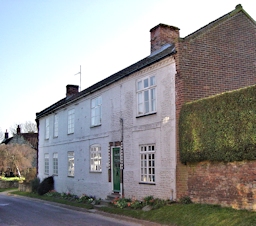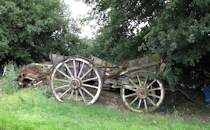Robert Kendle employed three men in his workshops, making and mending a variety of items from household articles, buildings, farm implements and vehicles. The skills and craftsmanship which emanated from these workshops were enormous and passed on by word, practice and experience.
Arthur Ramm ran the blacksmith's shop. In winter on their way home school children would go into the blacksmith's shop to warm themselves and remember seeing Arthur working, face red from the glare of the blazing forge, sweating, pumping the bellows - the sound of his hammer pounding the anvil. In summer and winter Arthur wore a woollen vest claiming ‘What keep the cold out keep the heat out’.
Shoeing Horses
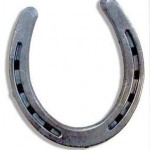 There was a constant flow of horses into the yard to be shod. He carefully
fitted the red-shoe, hissing as it was pressed onto the horn of horse’s hoof
with the distinct smell of burning horn. It was heavy work lifting the leg of a big cart horse and also a responsibllity, driving the nails in at the right angle was critical as severe damage could be done.
There was a constant flow of horses into the yard to be shod. He carefully
fitted the red-shoe, hissing as it was pressed onto the horn of horse’s hoof
with the distinct smell of burning horn. It was heavy work lifting the leg of a big cart horse and also a responsibllity, driving the nails in at the right angle was critical as severe damage could be done.
Horses were part of everyday life and a large part of Arthur’s work although there were other blacksmiths and farriers in Great Snoring. After the Second World War tractors came into use on farms, and horses began to disappear. Blacksmiths could shoe around ten heavy horses a day, and they needed to be shod about every three months.
Besides shoeing horses Arthur would have had other jobs, to keep the farm equipment running smoothly - mending chain harrows, potato lifters, reapers, and making spike harrows as well as forged hand tools, and the skilled work of shrinking metal tyres to wooden wheels.
Carpenters
Bob Kendle, his son Bob junior, and Billy Smith were the carpenters and spent their time ankle deep in wood shavings.
They were involved in a variety of work catering for a purely local community. From making and repairing household articles, buildings, farm implements, including harrows, field gates, wheelbarrows, elevators, used at harvest time, hurdles, and seed drills; to building farm wagons and carts. Like other carpenters' workshops it probably had tools arranged neatly on racks, with nests of drawers containing bolts, nails, washers and so forth. There would be also stools and cradles to support work.
Wagon-Building
The use of different types of wagons was essential in daily life, each district having its own style of wagon built to suit to the nature of the local countryside. Wainwrighting - the building of wagons - was a skilled craft, particularly the making of wheels or wheelwrighting.
Bob Kendle was a wainwright and Kendle’s Yard is where many vehicles used around the village were built.
Not all wheelwrights had their own blacksmith shop but at Kendle's Yard it was the complete oufit. The type of vehicles included two wheel tumbrils drawn by 1 or 2 horses, road wagons used to take corn to the mill and drawn by 4 horses. There were also smaller wagons for use on farms, pulled by 1 or 2 horses.
The finishing touches to a new wagon or cart was its painting often carried out by a visiting ‘liner’, usually painted red or blue with the owner's name and village, and they always had the hallmark of the maker. The building of a wagon could take several months.
Those from Kendle’s Yard were built mainly for use on Mr Perowne's farm and it is believed that one of these wagons can be seen at Holkham Bygones.
In the centre of the yard was a concrete circle used in the process of attaching the iron tyre to the wooden wheels. The iron was heated in a fire in the yard. The iron was stored in long lengths on the rafters of the barn.
Coffin-Maker
Like most viilage carpenters Bob Kendle was also the village undertaker: making coffins as the need arose, organising the funeral arrangements and providing bearers for the service, which he did until the Second World War.
Making coffins entailed special consideration. The wood was carefully selected for the beauty of grain. The curving of sides was not easy, achieved by partially cutting the wood on the inside and applying boiling water made curving the sides possible. Traditionally the ladies of carpenters' households took care of the linings of the coffin.
Timber was stored In the yard: oak, beech, ash and elm carefully chosen, usually bought when standing, then felled and brought to the yard for sawing and stacking, and allowed to season by air, atmosphere and time, usually around ten years. Oak was used for the wheel spokes and for the hub, well seasoned elm.
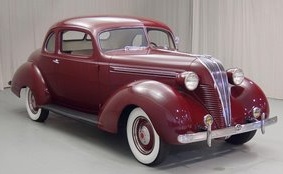 Taxi Service
Taxi Service
By 1933 Robert Kendle is recorded as carpenter and taxi driver, and the garage in the yard housed his car. In the 1930s it was a wine red Hudson Terraplane, later a Rover.
Bob junior was often on the move as taxi driver or he could be seen leading old Charlie the brown horse from his shed in the yard to the Rectory pightle to graze.
After work Kendle’s Yard was the place for the men of the village to meet and chat, referred to as the ‘Village Parliament’.
Bob would preside from his seat on the concrete base of the petrol pump, others gathered round to chew over various concerns, eventually wandering home as light faded.
Without these workshops, and the sound of metal tyred wagons, horses, the firing of traction engines, animals diven through the streets and children playing, how quiet the village is now.
Thanks to Gertie Cooper, Howard Frears, Audrey Seaman, Rev Harold Smith and Arthur and Peggy Yaxley for all the information provided, also East Anglian Crafts, The Village Wheelwright & Carpenter and The Forgotten Arts.

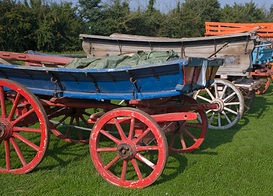
 There was a constant flow of horses into the yard to be shod. He carefully
fitted the red-shoe, hissing as it was pressed onto the horn of horse’s hoof
with the distinct smell of burning horn. It was heavy work lifting the leg of a big cart horse and also a responsibllity, driving the nails in at the right angle was critical as severe damage could be done.
There was a constant flow of horses into the yard to be shod. He carefully
fitted the red-shoe, hissing as it was pressed onto the horn of horse’s hoof
with the distinct smell of burning horn. It was heavy work lifting the leg of a big cart horse and also a responsibllity, driving the nails in at the right angle was critical as severe damage could be done.  Taxi Service
Taxi Service